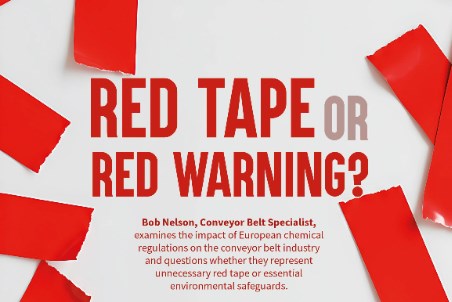Red Tape or Red Warning?
Published by Jody Dodgson,
Editorial Assistant
World Coal,

Especially within the past two decades, the EU/EEA has led the world in regulatory controls designed to protect human health and the environment.
Primarily aimed at the use of potentially harmful substances within the manufacturing process, there are long-standing regulations such as the registration, evaluation, and authorisation of chemical substances (REACH regulation EC 1907/2006) and EU Regulation No.2019/1021 Persistent Organic Pollutants (POPs).
Such regulations affect conveyor belt manufacturers, importers, traders, and end-users alike. But are they simply another example of ‘red tape interference’ from Brussels, or do they serve as a warning that needs to be taken much more seriously? To be able to answer that question it is first necessary to understand what the regulations are and what they are designed to achieve.
REACH stands for Registration, Evaluation, and Authorisation of CHemical substances, and was established by the EU with the specific aim to improve the protection of human health and the environment through better and earlier identification of the properties of chemical substances.
REACH places direct responsibility on industry to manage the risks from chemicals and to provide safety information. Manufacturers and importers are required by law to gather information on the properties of the chemical substances they use and register the information in a central database in the European Chemicals Agency (ECHA) based in Helsinki.
Nearly all the rubber used for conveyor belts is synthetic, and literally dozens of chemical components – such as anti-degradants, anti-ozonants, and accelerators – are used to make it. These include substances such as OTOS (N-oxydiethylene-2-benzothiazolesulfenamide, CAS 102-77-2). It is an inescapable fact that it is necessary to use some chemicals that are potentially extremely dangerous to humans and the environment. REACH calls for the progressive substitution of harmful chemicals, which are referred to as ‘substances of very high concern’ (SVHC’s) when suitable alternatives have been identified.
Anything to do with science is a process of continual evolution, so since its original introduction, regulation regarding SVHC has become increasingly stringent and demanding. For example, previous compliance was largely based on declaring (registering) the use of listed chemical substances and staying within specific limits applicable to each substance.
Now, however, regulations such as Article 31 demand that if a product contains an SVHC in a concentration greater than 0.1% of the total weight of the finished product, the manufacturer is compelled to register its use with the European Chemicals Agency (ECHA) and also provide the customer with a safety datasheet.
There is also Article 33 (obligation for supply of information to downstream users when SVHC >0.1%), which is important for importers and essential for compliance.
This is a preview of an article that was originally published in Issue 2 of World Coal 2025.
Subscribe to World Coal for free to read this article in full and many more here.
Read the article online at: https://www.worldcoal.com/coal/29102025/red-tape-or-red-warning/
